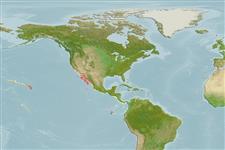>
Tetraodontiformes (Puffers and filefishes) >
Tetraodontidae (Puffers) > Tetraodontinae
Etymology: Sphoeroides: Greek, sphaira = ball + Greek, suffix, oides = similar to (Ref. 45335).
Environment: milieu / climate zone / depth range / distribution range
Ecologia
marino demersale; distribuzione batimetrica 5 - 20 m (Ref. 13103). Subtropical
Eastern Pacific: throughout the Gulf of California to Baja Magdalena.
Size / Peso / Age
Maturity: Lm ? range ? - ? cm
Max length : 35.2 cm TL maschio/sesso non determinato; (Ref. 39877)
Adults found in bays and over sandy bottoms, small juveniles often in more open areas over cobble or rocky bottoms (Ref. 13103).
Life cycle and mating behavior
Maturities | Riproduzione | Spawnings | Egg(s) | Fecundities | Larve
Walker, H.J. Jr. and W.A. Bussing, 1996. Two new pufferfishes fo the genus Sphoeroides from the Eastern Pacific. Copeia 1996(3):677-684. (Ref. 13103)
IUCN Red List Status (Ref. 130435)
Threat to humans
Harmless
Human uses
Pesca: commerciale
Strumenti
Special reports
Download XML
Fonti Internet
Estimates based on models
Preferred temperature (Ref.
123201): 17 - 25, mean 22.4 °C (based on 102 cells).
Phylogenetic diversity index (Ref.
82804): PD
50 = 0.5000 [Uniqueness, from 0.5 = low to 2.0 = high].
Bayesian length-weight: a=0.02291 (0.01026 - 0.05115), b=2.89 (2.72 - 3.06), in cm total length, based on LWR estimates for this Genus-body shape (Ref.
93245).
Trophic level (Ref.
69278): 3.5 ±0.4 se; based on size and trophs of closest relatives
Resilienza (Ref.
120179): Alto, tempo minimo di raddoppiamento della popolazione meno di 15 mesi (Preliminary K or Fecundity.).
Fishing Vulnerability (Ref.
59153): Low to moderate vulnerability (25 of 100).
